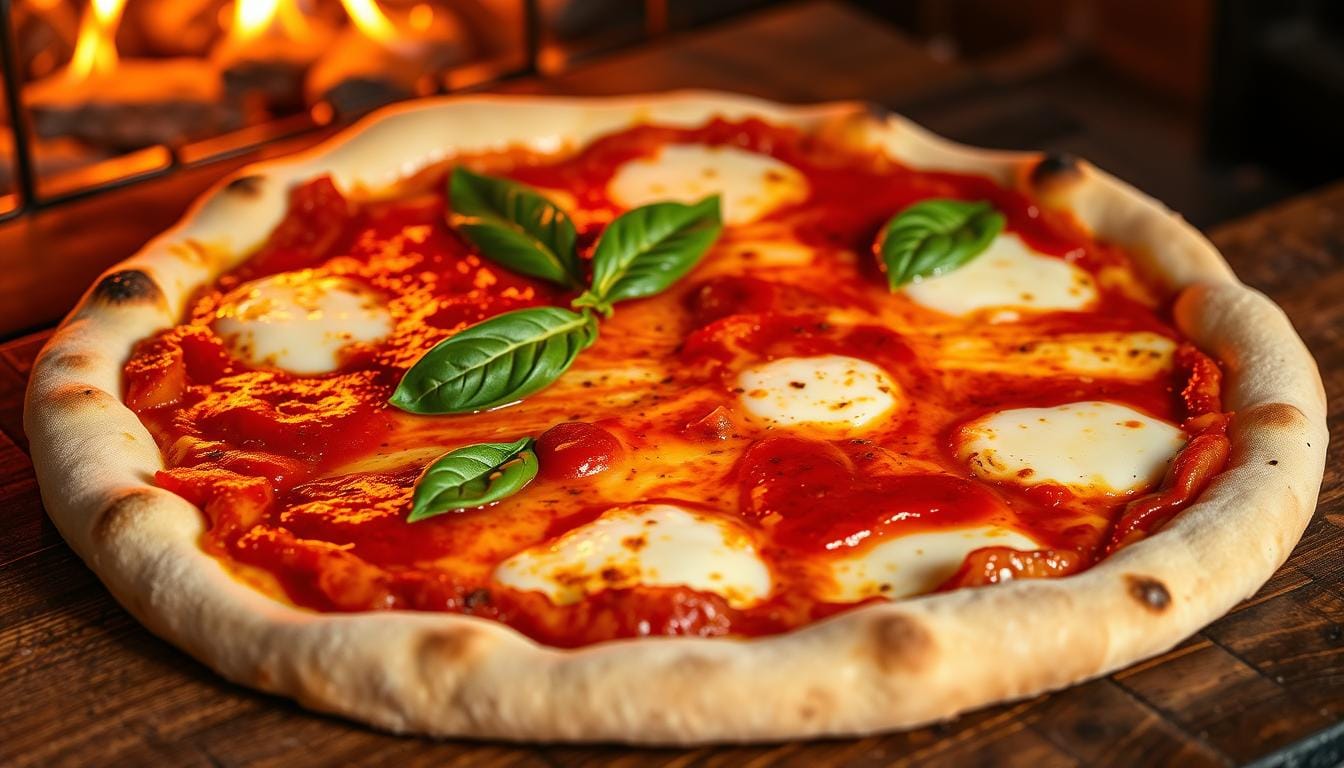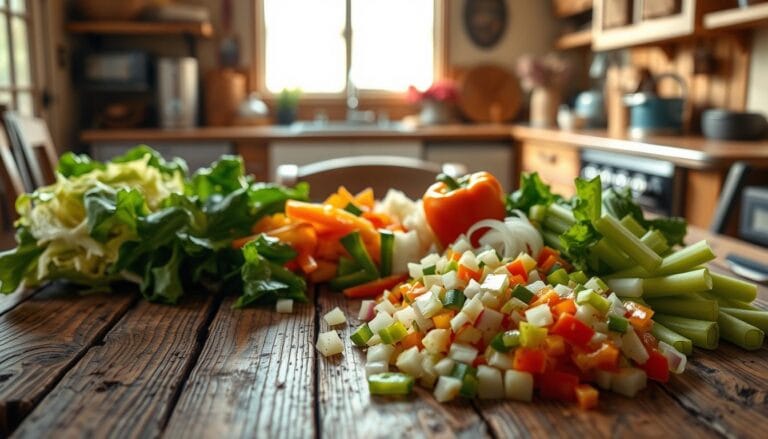Savor the Perfect Neapolitan Pizza: Delicious, Thin-Crust Perfection
My first bite of authentic neapolitan pizza in Naples changed everything. At L’Antica Pizzeria Da Michele, I watched the dough stretch into a golden, blistered circle. It was topped with San Marzano tomatoes and fresh mozzarella. That moment made me fall in love with italian cuisine.
I was determined to recreate that magic at home. Every bite was a balance of crisp edges, pillowy centers, and ingredients that tasted like sunlight.
This article shares how to master the art of authentic neapolitan pizza. You’ll learn how to craft dough so delicate it melts on your tongue. You’ll also learn to achieve that signature char with home ovens and pick the right ingredients to match the best of Italy. Let’s turn your kitchen into a little slice of Naples.
Table of Contents
What Makes Authentic Neapolitan Pizza Special
Every slice of authentic neapolitan pizza has a rich history. It’s different from other traditional pizza styles. Let’s see what makes it special.
The Rich History of Naples’ Most Famous Export
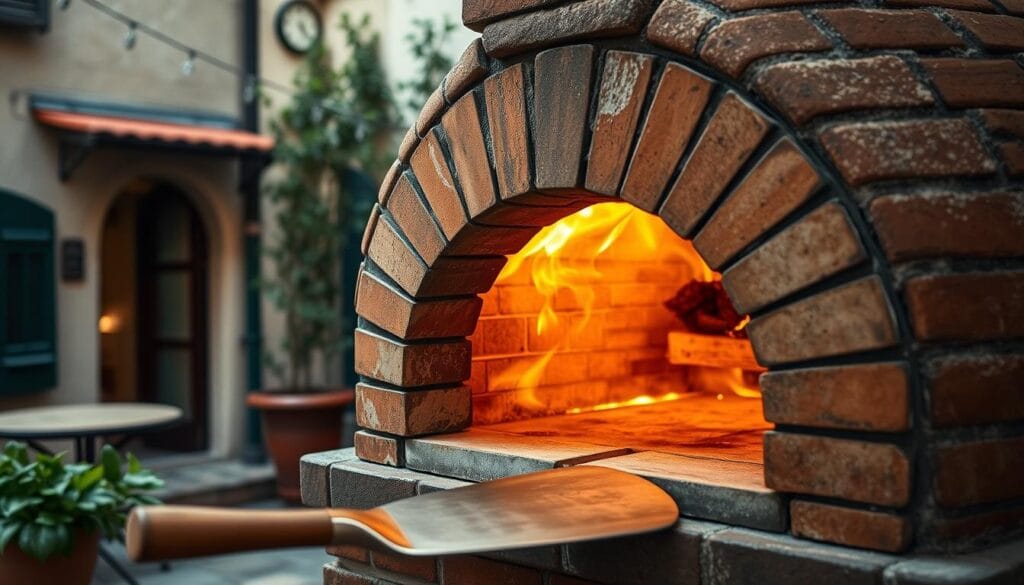
In the 18th century, Naples street vendors sold flatbreads. They topped them with tomatoes and cheese. But, 1889 was a turning point.
Pizzaiolo Raffaele Esposito made the naples style pizza we love today—the Margherita. He used basil, mozzarella, and tomato to honor Queen Margherita. Today, UNESCO calls this a cultural treasure.
Key Characteristics of True Neapolitan Pizza
Official standards from the Associazione Verace Pizza Napoletana are strict:
| Aspect | Standard |
|---|---|
| Dough | High hydration (58-65%), hand-kneaded with specific wheat flour |
| Ingredients | San Marzano tomatoes, buffalo mozzarella, and fresh basil |
| Baking | Wood-fired at 800-900°F for 60-90 seconds |
Why Wood-Fired Ovens Make a Difference
Wood-fired ovens are key to making this pizza. They char the crust, creating a unique look. The heat also keeps the center soft.
Modern ovens can’t match the crispness and softness of wood-fired ones. This is what makes the crust so special.
Essential Ingredients for the Perfect Neapolitan Pizza
Every bite of Neapolitan pizza is special because of the ingredients. We’ll look at each part, starting with the base.
Selecting the Right Flour for Your Dough
Neapolitan pizza dough begins with 00 flour. I prefer Caputo Pizzeria 00 flour for its smooth texture. Home bakers can use a mix of all-purpose and bread flour for a similar feel. Here’s the basic mix:
| Ingredient | Role |
|---|---|
| Caputo 00 Flour | Soft, elastic dough |
| Warm Water (600ml) | Activates yeast, hydrates dough |
| Salt (30g) | Controls yeast growth, enhances flavor |
| Yeast | For proper rise |
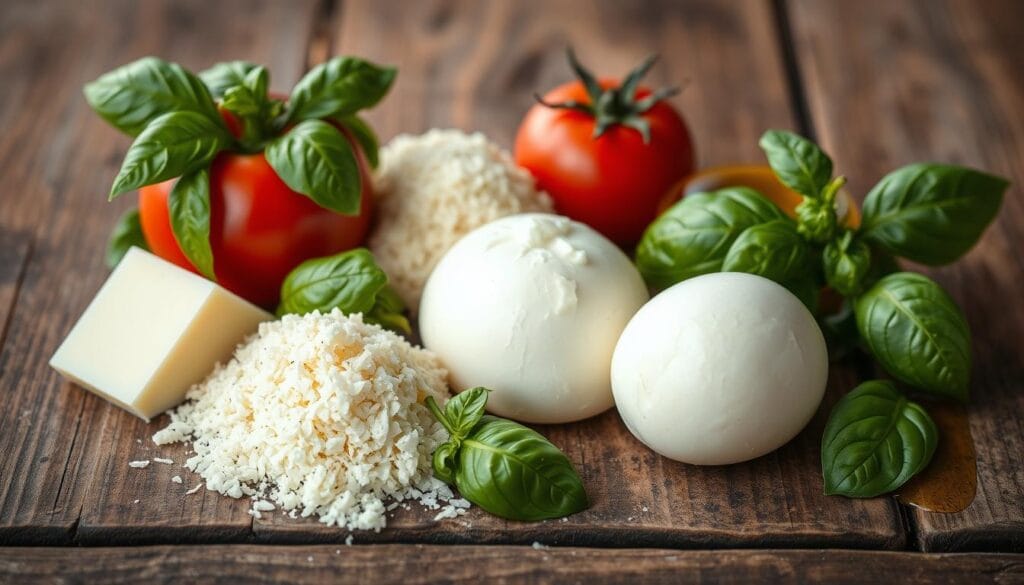
San Marzano Tomatoes: The Gold Standard
These tomatoes, grown in volcanic soil near Naples, are incredibly sweet. Make sure to buy DOP-certified cans. Here’s why they’re so great:
- Low acidity prevents bitterness
- Peeled skin makes peeling easy
- Puree them briefly to avoid overprocessing
“San Marzanos are the soul of Neapolitan sauce—they’re the only tomatoes that survive my no-additive sauce test.” – Naples-born pizzaiolo Marco De Marco
Fresh Mozzarella: Finding the Best Cheese
Buffalo fresh mozzarella melts the best, but cow’s milk fior di latte is a good substitute. A tip: drain slices in a colander 30 minutes before baking to avoid sogginess.
Basil and Olive Oil: Simple but Critical
Use fresh basil picked the same day as baking. Drizzle fresh mozzarella with extra virgin olive oil after baking for a burst of flavor. Avoid dried herbs, as they can’t match fresh.
My Fool-Proof Neapolitan Pizza Dough Recipe
Mastering neapolitan pizza begins with the right traditional pizza dough. My recipe has just four ingredients: Tipo 00 flour, filtered water, salt, and yeast. After years of testing, I found a 68% hydration dough. It’s perfect for balancing stretch and structure. Here’s how to make it:
- Ingredients (for 1 pizza):
- 2 cups (232g) King Arthur Flour tipo 00
- ¾ cup (170g) room-temperature water
- ¼ tsp instant yeast
- 1¼ tsp fine sea salt
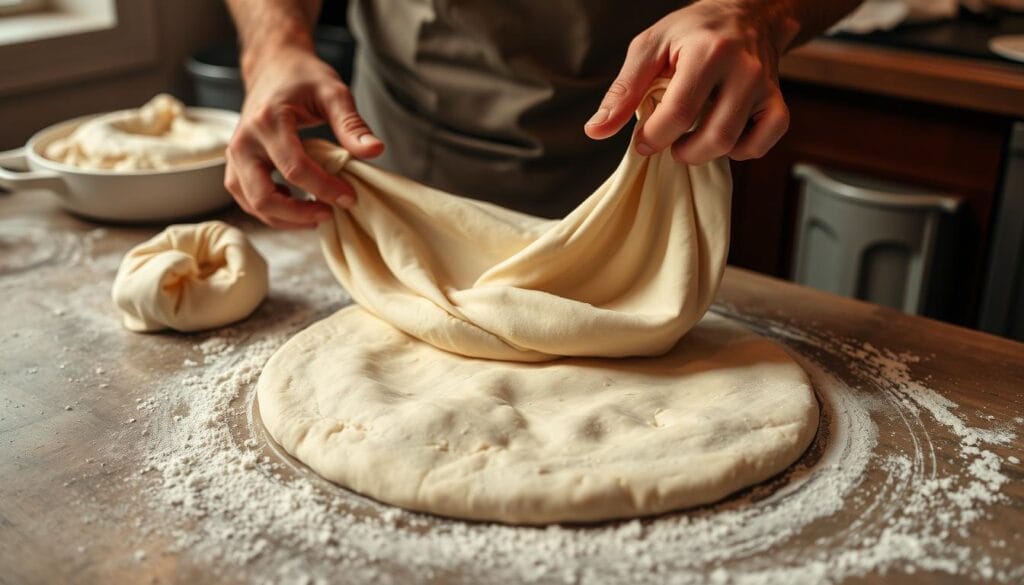
- Mix flour and yeast in a bowl. Add salt and water—never mix salt and yeast directly.
- Knead 5 minutes until sticky but smooth. Let rest 30 minutes.
- Perform 3 sets of stretch-and-folds every 30 minutes for 1.5 hours total.
- Cover and refrigerate for 24-48 hours for deep flavor development.
Pro tip: Cold fermentation is key for this traditional pizza dough. The secret is patience—long rests create that airy crumb. I freeze extra dough for quick use. Adjust hydration by 2-3% if your dough feels too sticky or dry. This neapolitan pizza base holds toppings perfectly when baked in a preheated oven at 500°F. Now you’re ready to craft pizza dough that rivals Naples’ best!
Mastering the Art of Thin-Crust Pizza Stretching
Getting your pizza dough just right turns your homemade neapolitan pizza into a work of art. Whether you use traditional pizza flour from Anson Mills or Lindley Mills, the right method is key. It balances crispiness with softness. Here’s how to make your pizza dough into that airy, bubbly crust everyone loves.

Hand-Stretching Techniques for Perfect Texture
First, let your neapolitan pizza dough rest for 15–20 minutes after shaping. Here’s how to stretch it like a pro:
- Use your fingertips to press outward from the center, rotating the dough slowly.
- Flip the dough and repeat the pressing motion to form a 12-inch circle with a raised edge.
- Support the dough with one hand while stretching outward with three fingers on the other hand.
- Let the dough rest again for 15 minutes post-stretching to relax gluten, ensuring it holds its shape in the oven.
Common Stretching Mistakes to Avoid
Don’t overwork your traditional pizza dough or you’ll end up with a dense crust. Steer clear of these mistakes:
- Stretching cold dough—warm it up to room temperature first.
- Over-flouring, which creates a dry crust. Use just enough to prevent sticking.
- Using rolling pins, which crush gluten and ruin the airy texture.
Achieving the Authentic Cornicione
The cornicione—the puffed, golden rim—is key. To perfect it:
- Leave the outer inch of the dough slightly thicker than the center.
- Rotate the dough while stretching to maintain even thickness.
- Let the dough rest on a floured surface before topping to set the edge’s shape.
Practice makes perfect. Invest in a Breville Pizzaiolo oven for authentic high-heat results. Remember, patience and practice are key. Your next slice is just around the corner!
Creating the Perfect Tomato Base for Traditional Pizza
For authentic neapolitan pizza, keep it simple. Use san marzano tomatoes for their sweet taste and low acidity. These tomatoes, from Italy’s Campania, are key in italian cuisine like pizza Margherita. I crush the tomatoes by hand to keep their texture.
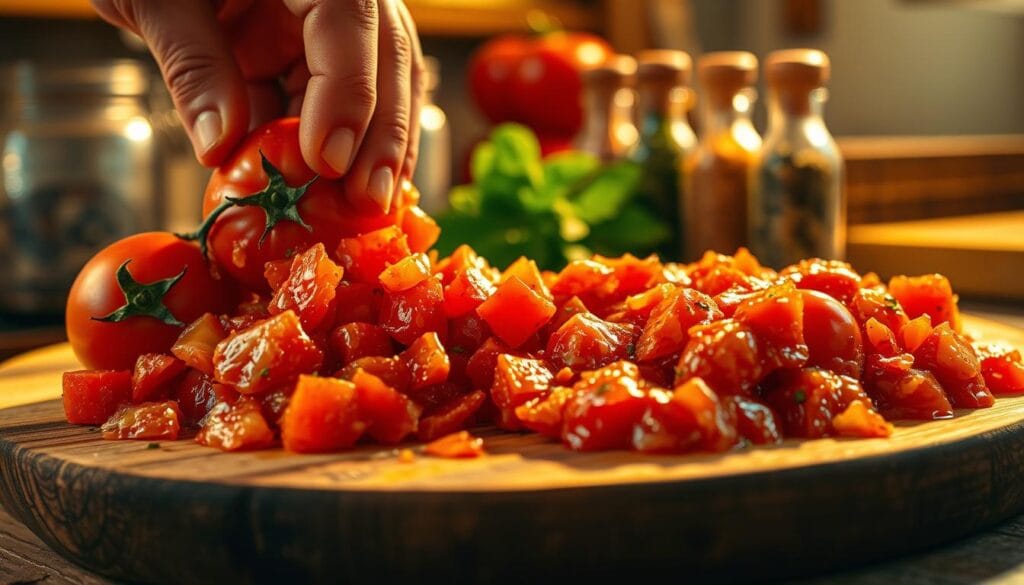
- 1 (28-ounce) can san marzano tomatoes (brands like Gustarosso or Rega)
- 1 tbsp extra virgin olive oil
- ½ tsp kosher salt
- Fresh basil or oregano (optional)
| Ingredient | Quantity |
|---|---|
| San Marzano tomatoes | 28 oz can |
| Olive oil | 1 tbsp |
| Kosher salt | ½ tsp |
| Basil/oregano | To taste |
Blend or crush tomatoes gently to avoid a paste-like consistency. Drizzle with olive oil and salt just before spreading—over-seasoning masks their natural sweetness. For long-term storage, freeze portions in ice cube trays for later use. Substitute with California Bianco diNapoli tomatoes if D.O.P. cans aren’t available.
Traditional italian cuisine focuses on letting ingredients shine. This simple approach ensures the authentic neapolitan pizza balances tomato brightness with fresh basil and mozzarella. Skip garlic and sugar—Naples chefs trust the tomato alone to shine!
Cooking Neapolitan Pizza at Home Without a Wood-Fired Oven
Wood-fired pizza ovens are the best for Naples style pizza. But, you can still make great pizza at home. These tips help you get that perfect char and airy crust without a brick oven.
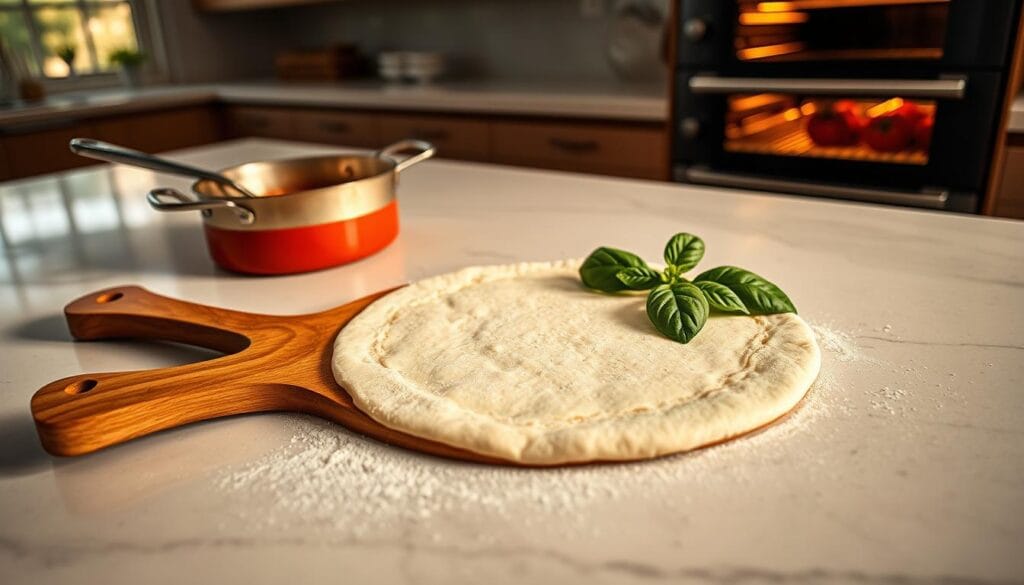
Pizza Stone and Home Oven Techniques
First, heat a pizza stone in your oven to 550°F for 45 minutes. Roll out the dough to 1/4-inch. Then, slide it onto the stone and bake for 5-7 minutes, flipping halfway for even browning.
For that special leopard spot look, broil the pizza’s top for 30 seconds. This trick makes your pizza crispy, just like in a wood-fired oven, using things you likely have at home.
Using a Pizza Steel for Better Results
A pizza steel heats up faster than stone. Heat it to 550°F for 30 minutes. Use a peel to put the dough on the steel and cook for 4-5 minutes.
Steel cooks your pizza 30% faster than stone. It’s also easier to clean and gives a crisper crust than other methods.
Alternative Cooking Methods Worth Trying
Try these creative ways to cook pizza:
- Skillet-Broiler Combo: Heat a cast-iron skillet to 500°F. Cook the dough for 3 minutes, then broil for 1-2 minutes for smoky charring.
- Outdoor Grill Magic: Place a pizza stone on the grill’s hottest spot. Cook for 2-3 minutes on each side for authentic char marks.
| Method | Setup | Pros | Cons |
|---|---|---|---|
| Pizza Stone | Oven rack in center | Affordable, even heat | Long preheating needed |
| Pizza Steel | Lower oven rack | Fast heat transfer | Costlier than stone |
| Ooni Oven | Backyard setup | Wood-fired taste | Requires outdoor space |
Small changes, like using Italian Tipo “00” flour or letting the dough rise for 5 hours, can make a big difference. With these tips, you can enjoy Naples style pizza at home, even without professional equipment.
Classic Neapolitan Pizza Variations to Explore
Discover the joy of authentic neapolitan pizza through its classic and regional twists. From timeless favorites to lesser-known local specialties, each variation honors traditional pizza techniques. It showcases the diversity of italian cuisine.
Margherita: The Original Classic
Every bite of margherita pizza tells a story. It was born in honor of Queen Margherita of Savoy. Its ingredients mirror Italy’s flag: red San Marzano tomatoes, white buffalo mozzarella, and green basil. Drizzle with olive oil just before serving to highlight its simplicity.
Pro tip: fold it “libretto” style—like a book—to savor the traditional pizza experience.
Marinara: Simplicity at Its Best
Marinara proves less is more. This garlic-kissed creation pairs oregano and cherry tomatoes with a no-cheese crust. It stays true to its origins as a quick meal for Neapolitan sailors.
The secret? Let the oregano shine without overpowering the fresh basil finish.
Regional Naples Variations Worth Trying
- Pizza Cosacca: Swap mozzarella for Pecorino cheese and add anchovies for a salty kick.
- Diavola: Spicy Calabrian chili peppers and cured salami add heat to the classic base.
- Quattro Formaggi: Layer fontina, gorgonzola, pecorino, and mozzarella for a creamy blend.
Always let the dough’s quality shine—toppings should enhance, not bury, its earthy flavor. Whether spicy or mild, these variations prove authentic neapolitan pizza is both a tradition and a canvas for creativity.
Troubleshooting Your Naples Style Pizza Problems
Even the most skilled cooks face challenges when making neapolitan pizza at home. Let’s tackle common problems and find solutions! If your naples style pizza dough sticks, it might be too wet or handled wrong. Try using 65–70% hydration for your pizza dough. Also, lightly flour your work surface with semolina or rice flour before stretching.
- Crumbly texture? It could be because the dough wasn’t kneaded enough. Fold the dough gently while shaping, then rest it for 10–15 minutes before stretching.
- Soggy crust? Too much sauce or cheese can cause it. Use a thin layer of San Marzano sauce and dry the mozzarella before adding.
- Flat, dense center? Check your oven’s temperature. Home ovens usually don’t get as hot as needed. Preheat a baking steel or stone to 500°F for even heat.
For uneven browning, try rotating the pizza halfway through baking. If the dough is overproofed, look for doubled-in-size bubbles. If it’s past its peak rise, start over. Always use active dry yeast that’s not expired for good rising.
Remember, neapolitan pizza is all about simplicity. Use only 3–4 toppings per slice to avoid it getting too heavy. If the crust is still too doughy, try making smaller dough balls and bake them on the oven’s lowest rack.
Every problem is a chance to learn! Change one thing at a time, like proofing time or oven position, to find the solution. With practice, your homemade naples style pizza will be as good as those in Naples.
Conclusion: Bringing a Taste of Naples to Your American Kitchen
My first taste of authentic Neapolitan pizza in Naples’ historic piazzas sparked a passion I’ve nurtured for years. The combination of a blistered crust, tangy San Marzano tomatoes, and fresh basil became my culinary North Star. Replicating the smoky kiss of a wood-fired oven at home takes patience, but it honors the heart of Italian cuisine.
Every batch of Caputo 00 flour, every rise of dough, and every experiment with homemade tomato sauce connects me to centuries of tradition. Start small—measure flour precisely, let dough rest, and trust the process. Even without a wood-fired oven, a preheated pizza stone can mimic the high-heat bake that defines authentic Neapolitan pizza.
My kitchen now buzzes with the same joy I felt in Naples, where simplicity and quality shine. The right ingredients—like Mutti passata and fresh buffalo mozzarella—elevate every slice, proving that Italian cuisine thrives when you honor its roots.
This isn’t just about pizza; it’s a celebration of hands-on cooking. Invite friends to stretch dough together, debate the perfect cheese-to-sauce ratio, and savor the warmth of shared meals. Every imperfect edge, every charred spot, tells a story. Your first homemade attempt may not rival Naples’ pizzerias, but it’s a stepping stone toward understanding why authentic Neapolitan pizza remains a timeless masterpiece.
The next time you crave Italian cuisine, why not roll up your sleeves and taste the magic yourself? Your kitchen—and your taste buds—will thank you.
FAQ
What is authentic Neapolitan pizza?
What makes Neapolitan pizza different from American-style pizza?
Why is the cooking method important for Neapolitan pizza?
How do I achieve the right dough consistency for Neapolitan pizza?
What are the best toppings for Neapolitan pizza?
How can I replicate the high temperatures of a wood-fired oven at home?
What is the key to achieving the perfect cornicione?
How can I troubleshoot common pizza-making challenges?
Can I use alternatives to San Marzano tomatoes?
What’s the best way to enjoy Neapolitan pizza?
Have You Tried Our Recipe Yet?
i tried this recipe and i like it
Absolutely delicious! 🍽️🔥 I tried your recipe, and it turned out amazing! The instructions were clear, and the flavors were perfectly balanced. Thank you for sharing such a fantastic dish—definitely adding this to my favorites! Can’t wait to see more recipes from you! 👏😍

